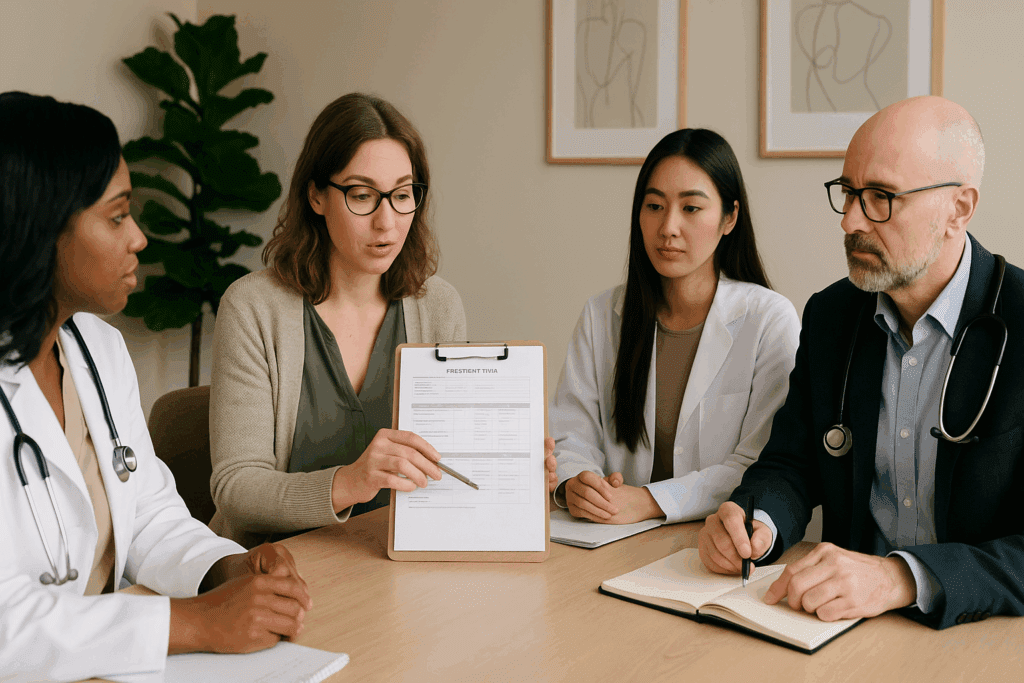Eating disorders are complex mental health conditions that intertwine physical health, psychological well-being, and social functioning. While they may begin with disordered eating behaviors, these conditions often evolve into entrenched patterns that require comprehensive and individualized care. An eating disorder treatment center provides specialized, evidence-based programs designed not only to restore nutritional health but also to rebuild emotional resilience, correct distorted thought patterns, and support long-term recovery. For those seeking effective healing, nutrition-focused rehab programs are essential, as they address one of the most critical yet overlooked aspects of the disorder—malnutrition and its profound impact on brain function and emotional regulation.
You may also like: How to Stop Emotional Eating and Regain Control: Mindful Nutrition Strategies That Support a Healthier Lifestyle
This article explores what you can expect from an eating disorder rehab program, particularly those offered by reputable eating disorder treatment facilities. From initial intake assessments to aftercare planning, we will examine how integrated clinical nutrition, psychotherapy, medical oversight, and family support all play vital roles in the recovery process. With a focus on real-world applications and current best practices, we aim to offer both clarity and encouragement for individuals and families navigating this often overwhelming journey.

Understanding the Role of an Eating Disorder Treatment Center
Eating disorder treatment centers are dedicated medical and therapeutic environments tailored to address the unique needs of individuals struggling with conditions such as anorexia nervosa, bulimia nervosa, binge eating disorder, and avoidant/restrictive food intake disorder (ARFID). Unlike general psychiatric or behavioral health clinics, eating disorder centers provide an intensive focus on nutrition and body image restoration, delivered through a team of multidisciplinary professionals.
These facilities are designed to create safe, structured spaces where individuals can begin to re-establish a healthy relationship with food and their bodies. Core components of care often include supervised meals, nutritional education, cognitive behavioral therapy (CBT), dialectical behavior therapy (DBT), and medical monitoring. By incorporating evidence-based interventions and individualized treatment plans, each eating disorder treatment center aims to guide patients from physical stabilization to psychological healing.
Importantly, these centers emphasize that eating disorders are not about vanity or superficial concerns but are rooted in deeper psychological and often neurobiological factors. This perspective informs a compassionate, non-judgmental approach to care that respects the individual’s experience while challenging harmful behaviors and thought patterns. Whether in a residential setting or an outpatient clinic, the goal remains the same: sustainable, long-term recovery.

Key Differences Between Eating Disorder Centers and General Mental Health Facilities
While both types of facilities address mental health concerns, eating disorder treatment facilities offer a distinct advantage in their specialized knowledge and targeted interventions. General mental health centers may lack the nuanced understanding of eating disorders’ medical and nutritional complications, which are often life-threatening and require specific clinical expertise.
For example, patients with anorexia may present with dangerously low body weight and electrolyte imbalances that can lead to cardiac complications. Without clinicians trained in eating disorder care, these physical risks can go unnoticed or untreated. Eating disorder clinics are staffed with registered dietitians, physicians, and therapists who are familiar with refeeding syndrome, metabolic monitoring, and other physiological aspects of the illness.
Moreover, eating disorder centers provide tailored meal planning, nutritional restoration strategies, and exposure-based eating experiences that help patients slowly rebuild trust with food. In contrast, a general facility might offer broad therapeutic approaches that fail to address the core behaviors associated with eating disorders. The integration of behavioral, psychological, and nutritional care in eating disorder treatment clinics allows for a more holistic and effective intervention.
Another significant distinction lies in the peer environment. In specialized eating disorder programs, patients are surrounded by others experiencing similar challenges, fostering a sense of community and shared understanding. This peer support can be particularly healing and motivates individuals to stay engaged in treatment, knowing they are not alone.

How Nutrition Therapy Anchors Recovery in Eating Disorder Rehab
Nutrition therapy is often the cornerstone of recovery in an eating disorder rehab center. Without restoring adequate nutrition and addressing food-related anxiety, psychological healing can be significantly impaired. The brain requires sufficient calories and nutrients to regulate mood, focus, and impulse control—all critical components of mental health. For individuals who have spent months or even years in a state of caloric restriction or binge/purge cycles, the body’s systems need comprehensive nutritional rehabilitation.
Registered dietitians in eating disorder rehabilitation centers work closely with each patient to develop meal plans that support both physical restoration and psychological flexibility. These plans typically evolve over time, starting with more structured and supervised meals before transitioning to intuitive eating strategies. The focus is not merely on weight gain or loss but on developing a normalized relationship with food.
A unique feature of nutrition therapy in these programs is its integration with exposure therapy. Patients may engage in “fear food” challenges, gradually reintroducing previously avoided foods in a safe and supportive setting. This process helps dismantle food-related anxieties and build resilience against relapse triggers.
Importantly, nutrition therapy also addresses nutritional myths and diet culture, which often contribute to the development of disordered eating. By helping patients reframe food as nourishment rather than an enemy or moral dilemma, eating disorder rehab centers support long-term change rooted in self-compassion and scientific understanding.

Frequently Asked Questions: Eating Disorder Treatment Centers and Rehab Programs
What are some early signs that someone may benefit from an eating disorder rehab program? Many individuals show subtle behavioral changes before fully realizing they need help. These signs may include increasing social withdrawal around meals, rigid food rituals, obsession with calories or exercise, and emotional volatility linked to food intake. While weight loss or gain may occur, it’s not always present, especially in those struggling with bulimia or binge eating disorder. Emotional symptoms like anxiety, depression, or obsessive-compulsive tendencies often appear before physical health declines. When these patterns begin to interfere with daily life, it may be time to consider support from an eating disorder treatment center or eating disorder clinic that offers specialized programs.
Can someone with a busy career or academic schedule still attend an eating disorder treatment center? Absolutely. Many eating disorder centers offer flexible levels of care, such as partial hospitalization programs (PHP) or intensive outpatient programs (IOP), which allow patients to maintain certain responsibilities while receiving treatment. These formats are particularly helpful for college students or working professionals who cannot step away from their commitments entirely but still require structured therapeutic support. Eating disorder rehab centers often provide evening sessions or weekend programming to accommodate various schedules. With the help of coordinated care teams, individuals can tailor their treatment plans to balance both recovery and real-life obligations.
How are cultural factors and identity considered at eating disorder rehabilitation centers? Modern eating disorder treatment facilities increasingly recognize the importance of cultural sensitivity. Individuals from diverse ethnic backgrounds, genders, sexual orientations, and socioeconomic statuses may face unique challenges that influence the development and presentation of eating disorders. High-quality treatment centers for eating disorders train staff in cultural competence and often employ specialists who can speak directly to these experiences. Inclusive care means offering space for open discussion about cultural beauty standards, intergenerational trauma, and community stigma. This inclusive framework allows eating disorder programs to become truly personalized, increasing the likelihood of sustained recovery.
What if someone doesn’t feel “sick enough” for an eating disorder treatment clinic? The idea of not being “sick enough” is a common and harmful myth that prevents many from seeking help. Eating disorders are mental health conditions that can be severe regardless of a person’s weight or appearance. Individuals who purge, binge, or engage in restriction—even without significant weight change—can face life-threatening consequences. Treatment centers for eating disorders prioritize psychological and behavioral patterns over physical metrics alone. It’s important to remember that early intervention at an eating disorder facility can prevent further physical and emotional decline, and it’s never too soon to get support.
Are virtual eating disorder programs effective for recovery? With advancements in telehealth, virtual eating disorder treatment clinics have become a viable option for many. While in-person care remains ideal for those with acute medical needs, virtual programs offer accessibility to those in remote areas or individuals with transportation or childcare limitations. These online formats can include individual therapy, meal support, nutritional counseling, and group sessions. Some eating disorder rehab centers have created hybrid programs that blend in-person and virtual services to provide continuity. Research shows that with proper structure and clinician involvement, virtual treatment can be effective—especially when supported by local medical providers.
How do eating disorder hospitals handle medical complications during treatment? Eating disorder hospitals are equipped to manage serious health concerns that accompany severe eating disorders. Electrolyte imbalances, cardiac arrhythmias, bone density loss, and gastrointestinal issues are just a few of the common complications that require close medical supervision. These facilities have interdisciplinary teams that include internal medicine physicians, psychiatrists, and nurses who understand the complex interaction between physical and psychological symptoms. In cases where inpatient medical stabilization is necessary, eating disorder hospitals provide round-the-clock care before transitioning the patient to lower levels of support. This continuum of care ensures that medical safety is never compromised during psychological treatment.
Can you explain the role of peer support in eating disorder rehab centers? Peer support is an invaluable aspect of recovery offered in many eating disorder rehab centers. Sharing experiences with others who understand the challenges of eating disorders helps reduce feelings of isolation and shame. Group therapy, communal meals, and peer-led discussions foster a sense of community and accountability. These relationships often create a safe space to challenge distorted beliefs and reinforce healthy coping mechanisms. Some eating disorder treatment facilities even incorporate alumni mentorship programs, where individuals further along in their recovery journey guide newer participants through the ups and downs of healing.
What makes a treatment center for anorexia different from other eating disorder programs? A treatment center for anorexia must address both the severe medical risks and the deeply entrenched cognitive distortions associated with the illness. These centers typically offer higher levels of care, including inpatient or residential programs, due to the potential for life-threatening malnutrition. Interventions focus on refeeding, restoring organ function, and helping patients reframe their self-worth beyond body size. Moreover, anorexia-specific treatment often includes advanced therapeutic modalities such as Cognitive Remediation Therapy (CRT) to enhance cognitive flexibility. The best eating disorder rehabilitation centers understand the nuances of anorexia nervosa and adjust their methods accordingly to optimize recovery.
How does an eating disorder treatment clinic support long-term recovery after discharge? Discharge planning is a crucial element of care at any high-quality eating disorder treatment clinic. Before leaving, patients work with their team to develop a step-down plan that may include outpatient therapy, nutrition counseling, and peer support groups. Many eating disorder centers maintain alumni programs that offer virtual check-ins, workshops, or community forums to stay connected. Some treatment centers also provide family follow-up sessions or relapse prevention coaching. The transition from structured care to everyday life can be challenging, and consistent follow-through significantly improves the likelihood of lasting recovery.
What should families consider when choosing an eating disorder facility? Families should look beyond aesthetics and marketing when evaluating an eating disorder facility. Key indicators of quality include accreditation, the presence of licensed and experienced staff, individualized treatment planning, and transparent outcome data. It’s also important to ask whether the center offers family-based therapy, as support from loved ones can be a major factor in recovery. Some eating disorder treatment centers specialize in specific populations, such as adolescents, LGBTQ+ individuals, or those with co-occurring disorders, so alignment with the patient’s identity and needs matters. Ultimately, a trustworthy eating disorder center will prioritize patient dignity, medical safety, and evidence-based care at every stage of the recovery process.

Multidisciplinary Teams in Eating Disorder Treatment Facilities
Comprehensive recovery requires the collaboration of a skilled, multidisciplinary team. In leading eating disorder treatment facilities, patients are supported by a network of professionals that typically includes registered dietitians, licensed therapists, medical doctors, psychiatrists, and sometimes occupational therapists and yoga instructors. Each professional contributes their expertise to address a specific aspect of the disorder.
This team-based model ensures that all areas of a patient’s health are treated simultaneously. For example, while a physician monitors vital signs and physical health, a dietitian focuses on nutrition restoration, and a therapist guides the individual through trauma work or body image concerns. Weekly team meetings are common, during which clinicians review progress and adjust treatment plans collaboratively.
Multidisciplinary care also allows for individualized treatment. No two eating disorders are alike, and successful intervention requires a plan that respects the patient’s history, comorbidities, personality, and readiness for change. In high-quality eating disorder treatment clinics, this customization is standard practice, ensuring that care is never one-size-fits-all.
Family involvement is often encouraged and may be facilitated by a family therapist or counselor on the treatment team. Recognizing the impact of familial dynamics on recovery, many centers incorporate psychoeducation and support for loved ones to help them better understand how to offer meaningful support without enabling disordered behaviors.
By integrating a range of perspectives and skill sets, multidisciplinary teams enhance both the precision and the depth of care offered, leading to stronger outcomes and improved long-term stability.
Was this article helpful? Don’t let it stop with you. Share it right now with someone who needs to see it—whether it’s a friend, a colleague, or your whole network. And if staying ahead on this topic matters to you, subscribe to this publication for the most up-to-date information. You’ll get the latest insights delivered straight to you—no searching, no missing out.

